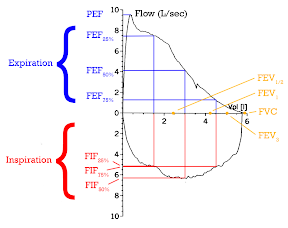 A 4-page survey was mailed to a national, random sample of office-based family physicians and pediatricians.
A 4-page survey was mailed to a national, random sample of office-based family physicians and pediatricians.Among the 360 respondents who provided care to children with asthma:
- 52% used spirometry in clinical practice
- 80% used peak flow meters
- 10% used no lung function tests
Only 21% routinely used spirometry for all guideline-recommended clinical situations.
More family physicians than pediatricians reported using spirometry (75% vs 35%).
Family physicians were more comfortable in interpreting spirometric results (50% vs 25%).
Only 50% of respondents interpreted correctly the spirometric results in a standardized clinical vignette. Frequency of underrating asthma severity increased with the inclusion of spirometric results.
The most common barriers to the use of spirometry were time and training.
The use of spirometry in primary care settings for children with asthma does not conform to national guidelines.
References:
Spirometry Use Among Pediatric Primary Care Physicians. PEDIATRICS Vol. 126 No. 4 October 2010, pp. 682-687 (doi:10.1542/peds.2010-0362).
Daily home spirometry does not reduce exacerbations in children with severe asthma. ERJ, 2012.
More family physicians than pediatricians reported using spirometry (75% vs 35%).
Family physicians were more comfortable in interpreting spirometric results (50% vs 25%).
Only 50% of respondents interpreted correctly the spirometric results in a standardized clinical vignette. Frequency of underrating asthma severity increased with the inclusion of spirometric results.
The most common barriers to the use of spirometry were time and training.
The use of spirometry in primary care settings for children with asthma does not conform to national guidelines.
References:
Spirometry Use Among Pediatric Primary Care Physicians. PEDIATRICS Vol. 126 No. 4 October 2010, pp. 682-687 (doi:10.1542/peds.2010-0362).
Daily home spirometry does not reduce exacerbations in children with severe asthma. ERJ, 2012.
PFTs: Question everything http://bit.ly/1j7WYTz
Image source: Spirometry, from Wikipedia, the free encyclopedia, GNU Free Documentation License.